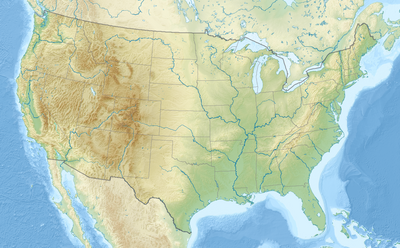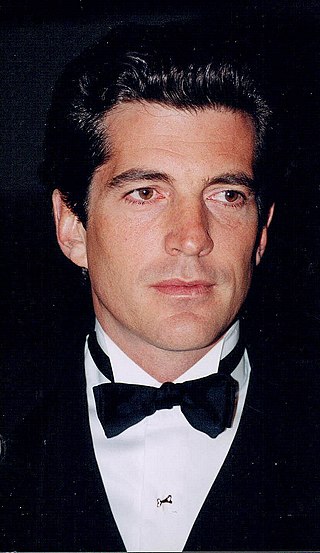
John Fitzgerald Kennedy Jr., often referred to as John-John or JFK Jr., was an American attorney, journalist, and magazine publisher. He was a son of John F. Kennedy, the 35th president of the United States and First Lady Jacqueline Kennedy, and a younger brother of U.S. Ambassador Caroline Kennedy. Three days after his father was assassinated, he rendered a final salute during the funeral procession on his third birthday.

Westchester County Airport is a county-owned airport in Westchester County, New York, three miles (6 km) northeast of downtown White Plains, with territory in the towns of North Castle and Harrison, New York, and village of Rye Brook, New York. It is sometimes referred to as the White Plains Airport and is so identified by the Official Airline Guide (OAG).
Spatial disorientation results in a person being unable to determine their position or relative motion, commonly occurring during periods of challenging visibility, since vision is the dominant sense for orientation. The auditory system, vestibular system, and proprioceptive system collectively work to coordinate movement with balance, and can also create illusory nonvisual sensations, resulting in spatial disorientation in the absence of strong visual cues.
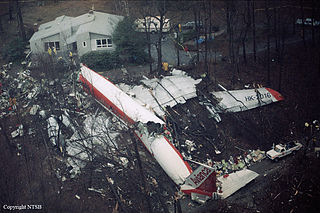
Avianca Flight 052 was a regularly scheduled flight from Bogotá, Colombia, to New York City, United States, via Medellín, Colombia, that crashed on January 25, 1990, at 21:34 (UTC−05:00). The Boeing 707 flying this route ran out of fuel after a failed attempt to land at John F. Kennedy International Airport (JFK), causing the aircraft to crash onto a hillside in the small village of Cove Neck, New York, on the north shore of Long Island. Eight of the nine crew members and 65 of the 149 passengers on board were killed. The National Transportation Safety Board (NTSB) determined that the crash occurred due to the flight crew failing to properly declare a fuel emergency, failure to use an airline operational control dispatch system, inadequate traffic flow management by the Federal Aviation Administration (FAA), and the lack of standardized understandable terminology for pilots and controllers for minimum and emergency fuel states.
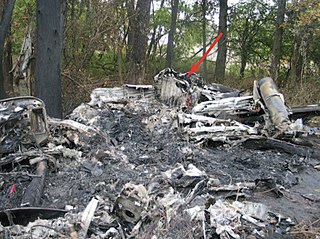
Corporate Airlines Flight 5966 was a scheduled passenger flight from St. Louis, Missouri, to Kirksville, Missouri. On October 19, 2004, the Jetstream 32 operating the flight crashed on approach to Kirksville Regional Airport due to pilot error. Thirteen people were killed.
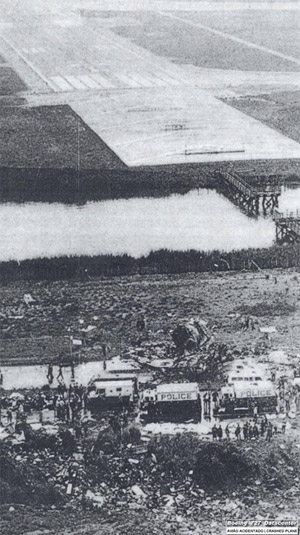
Eastern Air Lines Flight 66 was a regularly scheduled flight from New Orleans to New York City that crashed on June 24, 1975 while on approach to New York's John F. Kennedy International Airport, killing 113 of the 124 people on board. The crash was determined to be caused by wind shear caused by a microburst, but the failure of the airport and the flight crew to recognize the severe weather hazard was also a contributing factor.

Essex County Airport, informally known as Caldwell Airport, is a public use airport located in Fairfield Township, Essex County, New Jersey, two nautical miles (4 km) north of the central business district of Caldwell, a borough of northwestern Essex County in the U.S. state of New Jersey. It is owned by the Essex County Improvement Authority. This facility is included in the National Plan of Integrated Airport Systems for 2011–2015, which categorized it as a general aviation reliever airport.
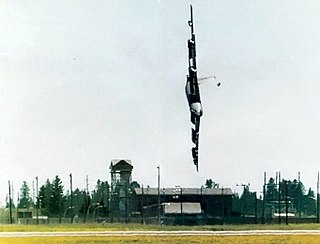
Pilot error generally refers to an accident in which an action or decision made by the pilot was the cause or a contributing factor that led to the accident, but also includes the pilot's failure to make a correct decision or take proper action. Errors are intentional actions that fail to achieve their intended outcomes. The Chicago Convention defines the term "accident" as "an occurrence associated with the operation of an aircraft [...] in which [...] a person is fatally or seriously injured [...] except when the injuries are [...] inflicted by other persons." Hence the definition of "pilot error" does not include deliberate crashing.

The Piper PA-32R is a six-seat, high-performance, single engined, all-metal, fixed-wing aircraft produced by Piper Aircraft of Vero Beach, Florida. The design began life as the Piper Lance, a retractable-gear version of the Piper Cherokee Six. Later models became known by the designation Piper Saratoga. The primary difference between the Lance and early Saratoga is the development of a tapered wing on the Saratoga, replacing the "Hershey bar" wing on the Lance that was a carryover from the Cherokee Six. Later Saratoga models provided updated/improved avionics, engine and interior touches but retained the same airframe design.

Southwest Airlines Flight 1248 was a scheduled passenger flight from Baltimore, Maryland, to Chicago, Illinois, continuing on to Salt Lake City, Utah, and then to Las Vegas, Nevada. On December 8, 2005, the airplane slid off a runway at Chicago-Midway while landing in a snowstorm and crashed into automobile traffic, killing a six-year-old boy.

Human senses are not naturally geared for the inflight environment. Pilots may experience disorientation and loss of perspective, creating illusions that range from false horizons to sensory conflict with instrument readings or the misjudging of altitude over water.

Addison Airport is a public airport in Addison, in Dallas County, Texas, United States, 9 mi north of downtown Dallas. It opened in 1954 and was purchased by the town of Addison in 1976. It is home to the Cavanaugh Flight Museum.
Campbell Airport is a public-use airport located two miles (3 km) southwest of the central business district of Grayslake, a village in Lake County, Illinois, United States. It is privately owned by Kane Illinois Properties, Inc.

Carolyn Jeanne Bessette-Kennedy was an American publicist for Calvin Klein. After her marriage to John F. Kennedy Jr., Bessette-Kennedy's relationship with her husband and her fashion sense became the subjects of media scrutiny, drawing comparisons to her mother-in-law Jacqueline Kennedy Onassis. The couple as well as Bessette-Kennedy's older sister, Lauren, died in a plane crash off the coast of Martha's Vineyard on July 16, 1999.
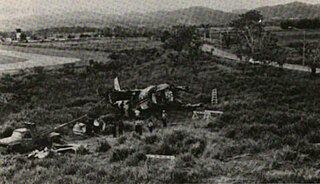
American Eagle Flight 5452, officially operating as Executive Air Charter Flight 5452, was a commuter flight between Luis Muñoz Marín International Airport in San Juan, Puerto Rico and Eugenio María de Hostos Airport in Mayagüez. The flight was operated by Executive Air Charter, doing business as American Eagle, and was operated by a CASA C-212 Aviocar aircraft. Visual meteorological conditions were present as the plane made its final approach to runway 9 at Mayagüez on May 8, 1987. The plane crashed 600 feet short of the runway, destroying the aircraft and killing both pilots, but leaving the four passengers with only minor injuries.
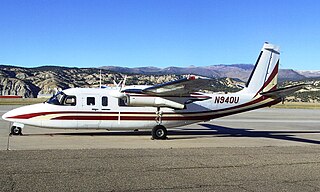
The 1971 Colorado Aviation Aero Commander 680 crash claimed the life of decorated American World War II veteran Audie Murphy and five other people on May 28, 1971. The aircraft's passengers were on a business trip from Atlanta, Georgia, to Martinsville, Virginia, aboard an Aero Commander 680 Super twin-engined aircraft owned and operated by Colorado Aviation Co, Inc. The aircraft crashed into the side of Brush Mountain, 14 nautical miles northwest of Roanoke, Virginia, during conditions of poor visibility.

On March 5, 1963, American country music performers Patsy Cline, Cowboy Copas, and Hawkshaw Hawkins were killed in an airplane crash near Camden, Tennessee, United States, along with the pilot Randy Hughes. The accident occurred as the three artists were returning home to Nashville, Tennessee, after performing in Kansas City, Kansas.

Atlas Air Flight 3591 was a scheduled domestic cargo flight under the Amazon Air banner between Miami International Airport and George Bush Intercontinental Airport in Houston. On February 23, 2019, the Boeing 767-375ER(BCF) used for this flight crashed into Trinity Bay during approach into Houston, killing the two crew members and single passenger on board. The accident occurred near Anahuac, Texas, east of Houston, shortly before 12:45 CST (18:45 UTC). This was the first fatal crash of a Boeing 767 freighter.

On 29 May 2021, a Cessna 501 Citation I/SP crashed into the Percy Priest Lake in Tennessee. All seven occupants died, including diet guru Gwen Shamblin Lara and her husband, actor Joe Lara. In a report released on March 22, 2023, the National Transportation Safety Board (NTSB) determined that the cause of the accident was "the pilot's loss of airplane control during climb due to spatial disorientation."
Oceana County Airport is a public use airport located between the cities of Hart and Shelby, Michigan. It is publicly owned by the Oceana County Court House.

